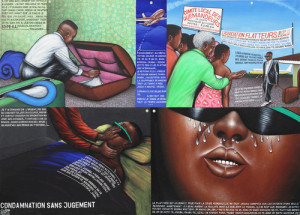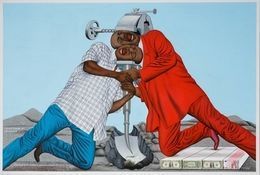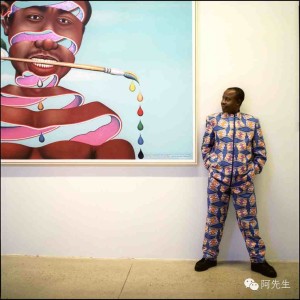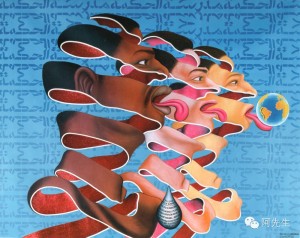
In Collection: Chéri Samba, Condemnation without Judgement, 1989-1990, MoMA New York
About this artist
 Oui il faut réfléchir, 2014.
Oui il faut réfléchir, 2014.
Congolese painter. Born David Samba, in 1972 he changed his name to Samba wa Mbimba-N’Zinga-Nuni Masa per the government’s authenticity policy. His father was a blacksmith and wanted Samba to be one too. He left secondary school after one year in 1970, moving to Kinshasa in 1972 to live with an uncle. He admired Apuza’s paintings displayed on a main street and was apprenticed to him briefly, after which he worked with two other artists, only to leave them and return to Apuza as his partner. In 1975 he established his own workshop. From 1975 to 1978 he worked for a local African clientele; from 1978 to 1982 his canvassize increased and his audience expanded to include Europeans in Kinshasa. In 1979, the year after his first exhibition, he adopted Chéri Samba as his professional name. In 1982 his paintings were exhibited for the first time in Europe, and their success resulted in his working almost exclusively for an international Western audience.
 L’Employeur et l’employé, 2013.
L’Employeur et l’employé, 2013.
Samba began as a sign painter, as can be seen in his use of image and text. His pieces comment on urban Africa and Paris in a moral and cautionary sense, as seen in Mosali Nzela (1991; Geneva, Jean Pigozzi priv. col.). Skilled in naturalistic rendering, he occasionally exaggerates features, underscoring his moral lesson. His paintings are usually crowded with varied moving figures, as seen in Grace na tata Mobutu (1986). Self-portraits are frequent, and his palette is bright and cheerful. He uses French, English, Lingala and a French patois to narrate his pictures, often over much of their surfaces, and has said, ‘The texts that I introduce on my canvases translate the thoughts of the people I depict in a given situation. It is a way of not allowing freedom of interpretation to a person who looks at my painting. For me, my work is incomplete if there aren’t any texts; they symbolize the fantasy.’ Writing about Samba’s style, Jewsiewicki noted, ‘Each painting is a kaleidoscope where the original and the borrowed, the old and the new, the local and the global coexist.’ Samba participated in many major exhibitions, including the first Biennial of Contemporary Bantu Art (Libreville, 1985); Magiciens de la terre (Paris, 1989) and Africa Explores: 20th Century African Art (New York, 1991).
Jean-Pierre Ibio
Portait + I like color, 2003.
 Quel avenir pour notre art, 1997.
Quel avenir pour notre art, 1997.
From Grove Art Online
© 2009 Oxford University Press


